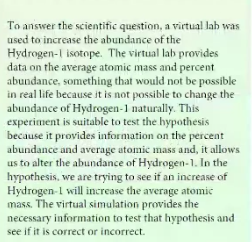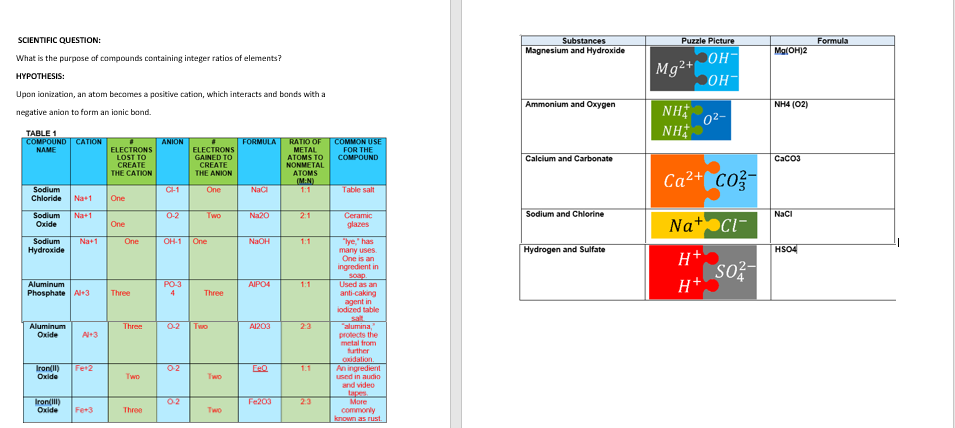Two simulations that were used are below: This activity is structured as a game, wherein your challenge is to create correct ionic compound formulas by combining individual ions based on their charges. Once you correctly connect the atoms in the interactive website, a common use for that compound will be revealed. In this worksheet, you must record both the correct formula for each of the seven ionic compounds and their common uses as revealed by the interactive program. Throughout the activity, you will have the option of skipping each compound – if you choose to do this, its common use will not be revealed. You must correctly write the formulas and match the common uses. Website for first simulation: https://www.learner.org/wp-content/interactive/periodic/bonding Click “Begin” on the first page you see. For each compound name listed at the top of the interactive, choose the correct cation and anion which you think belong to the formula for that compound. For example: Sodium Chloride, click “Na+” and “Cl-“. 3. Drag one ion on top of the other until the two ions you want to connect are highlighted yellow. We recorded this info in a table. The second/last simulation: Open the following website: https://javalab.org/en/ion_model_en/ Use the puzzle pieces to form the ionic compounds listed in data table 2, and then fill in data table 2 with that information. Write the formula for that compound and draw or copy and paste your completed puzzle for each ionic compound into the table. Explain the virtual labs used and what they helped show us. An example of how to answer this is below. The charts created from the simulations are below as well.
Formal Charges
Formal charges have an important role in organic chemistry since this concept helps us to know whether an atom in a molecule is neutral/bears a positive or negative charge. Even if some molecules are neutral, the atoms within that molecule need not be neutral atoms.
Polarity Of Water
In simple chemical terms, polarity refers to the separation of charges in a chemical species leading into formation of two polar ends which are positively charged end and negatively charged end. Polarity in any molecule occurs due to the differences in the electronegativities of the bonded atoms. Water, as we all know has two hydrogen atoms bonded to an oxygen atom. As oxygen is more electronegative than hydrogen thus, there exists polarity in the bonds which is why water is known as a polar solvent.
Valence Bond Theory Vbt
Valence bond theory (VBT) in simple terms explains how individual atomic orbitals with an unpaired electron each, come close to each other and overlap to form a molecular orbital giving a covalent bond. It gives a quantum mechanical approach to the formation of covalent bonds with the help of wavefunctions using attractive and repulsive energies when two atoms are brought from infinity to their internuclear distance.
Two simulations that were used are below:
This activity is structured as a game, wherein your challenge is to create correct ionic compound formulas by combining individual ions based on their charges. Once you correctly connect the atoms in the interactive website, a common use for that compound will be revealed. In this worksheet, you must record both the correct formula for each of the seven ionic compounds and their common uses as revealed by the interactive program.
Throughout the activity, you will have the option of skipping each compound – if you choose to do this, its common use will not be revealed. You must correctly write the formulas and match the common uses.
Website for first simulation: https://www.learner.org/wp-content/interactive/periodic/bonding
- Click “Begin” on the first page you see.
- For each compound name listed at the top of the interactive, choose the correct cation and anion which you think belong to the formula for that compound.
For example: Sodium Chloride, click “Na+” and “Cl-“.
3. Drag one ion on top of the other until the two ions you want to connect are highlighted yellow. We recorded this info in a table.
The second/last simulation:
Open the following website: https://javalab.org/en/ion_model_en/
Use the puzzle pieces to form the ionic compounds listed in data table 2, and then fill in data table 2 with that information. Write the formula for that compound and draw or copy and paste your completed puzzle for each ionic compound into the table.
Explain the virtual labs used and what they helped show us. An example of how to answer this is below. The charts created from the simulations are below as well.


Trending now
This is a popular solution!
Step by step
Solved in 2 steps









